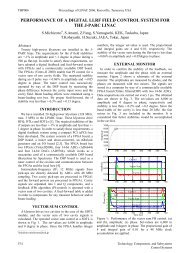Design and Development of a Diagnostics Client for a Beam Loss ...
Design and Development of a Diagnostics Client for a Beam Loss ...
Design and Development of a Diagnostics Client for a Beam Loss ...
Create successful ePaper yourself
Turn your PDF publications into a flip-book with our unique Google optimized e-Paper software.
<strong>Design</strong> <strong>and</strong> <strong>Development</strong> <strong>of</strong> a <strong>Diagnostics</strong> <strong>Client</strong> <strong>for</strong> a <strong>Beam</strong> <strong>Loss</strong> Measurement System at CERN<br />
count number request refers also to data bundles, even though UDP has no restriction <strong>for</strong><br />
the payload size <strong>of</strong> the datagrams. This is <strong>for</strong> simplicity reasons. In Figure 10, a BLEDP<br />
bundle <strong>of</strong> size 350 <strong>and</strong> one <strong>of</strong> its acquisition frames is shown.<br />
4.3.3 Data Sent by the Server<br />
Figure 10: BLEDP bundle <strong>and</strong> Acquisition frame<br />
There are two types <strong>of</strong> data sent by the embedded server inside the BLEDP cards. The<br />
first type is the acquisition data frames stored inside fixed-size buffers (bundles) as already<br />
mentioned in the previous chapter. The second type is the status data frames. This type is<br />
also transmitted inside fixed-size buffers <strong>and</strong> is interleaving in parallel with the acquisition<br />
data from the established TCP socket.<br />
4.3.3.1 BLEDP Acquisition Frame<br />
The BLEDP acquisition frame is the main packet produced by the FPGA <strong>and</strong> sent by the<br />
embedded server. The monitoring <strong>of</strong> these packets is the main goal <strong>of</strong> the design <strong>and</strong><br />
development process <strong>of</strong> the client application.<br />
In the final operating version <strong>of</strong> the system, several beam loss detectors like secondary<br />
emission monitors, diamonds, Cherenkov detectors <strong>and</strong> ionization chambers are going<br />
to be connected to the input <strong>of</strong> the acquisition system. The system makes use <strong>of</strong> two<br />
measurement acquisition methods, described in the corresponding chapters, <strong>and</strong> pro-<br />
duces digital processed data out <strong>of</strong> the analog input signal. One processed data frame<br />
is produced every 2 μs <strong>for</strong> each <strong>of</strong> the 8 acquisition channels. The embedded server<br />
“talks” directly to the hardware enabling the transmission <strong>of</strong> these acquired processed<br />
data points.<br />
Each processed data frame is acquired <strong>and</strong> manipulated by the embedded server into a<br />
32-bit integer point with header, sequence number <strong>and</strong> payload. There are 6 bits com-<br />
posing the header with 3 types <strong>of</strong> in<strong>for</strong>mation. Subsequently, there are 6 bits <strong>of</strong> sequence<br />
after the header <strong>for</strong> the processed data. These bits indicate an incremental counter value<br />
<strong>for</strong> debugging purposes. The range <strong>of</strong> this number goes up to its maximum value <strong>and</strong> then<br />
rolls back to 0. Lastly, the next bits indicate the payload value. The detailed in<strong>for</strong>mation<br />
about the BLEDP acquisition packet structure is shown in table 1.<br />
Emmanouil I. Angelogiannopoulos 26















